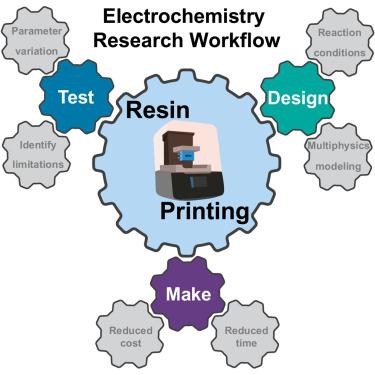当前位置:
X-MOL 学术
›
Chem Catal.
›
论文详情
Our official English website, www.x-mol.net, welcomes your
feedback! (Note: you will need to create a separate account there.)
Resin 3D printing enables accessible electrochemical cell design
Chem Catalysis ( IF 11.5 ) Pub Date : 2024-09-27 , DOI: 10.1016/j.checat.2024.101120 Nicholas B. Watkins, Cyrus J.B.M. Fiori, Florian M. Grass, Jonas C. Peters, John M. Gregoire, Alexis T. Bell, Julia R. Greer, Max A. Saccone, Justin C. Bui
Chem Catalysis ( IF 11.5 ) Pub Date : 2024-09-27 , DOI: 10.1016/j.checat.2024.101120 Nicholas B. Watkins, Cyrus J.B.M. Fiori, Florian M. Grass, Jonas C. Peters, John M. Gregoire, Alexis T. Bell, Julia R. Greer, Max A. Saccone, Justin C. Bui

|
With a recent surge in electrochemical technologies, the number of electrochemical cell designs for applications ranging from biosensors to high-current electrolyzers has grown massively. While electrode and electrocatalyst materials have been the traditional focus of electrochemistry research, the expanded experimental and computational study of dynamic conditions within electrochemical cells has revealed the importance of co-designing the cell’s components. Additive manufacturing via 3D printing has historically been used to prototype parts before getting them machined out of materials with more favorable properties. However, developments in printer accuracy, filament and resin robustness, and printer accessibility in recent years have broadened the scope of the potential applications of additive manufacturing. In this perspective, we provide insight into the acceleration of reactor design and implementation for electrochemistry and catalysis facilitated by advances in vat photopolymerization.
中文翻译:

树脂 3D 打印可实现电化学电池设计
随着近年来电化学技术的迅猛发展,从生物传感器到高电流电解槽等应用的电化学电池设计数量大幅增长。虽然电极和电催化剂材料一直是电化学研究的传统焦点,但电化学电池内动态条件的扩展实验和计算研究揭示了共同设计电池组件的重要性。历史上,通过 3D 打印增材制造一直用于制作零件原型,然后再用具有更有利性能的材料加工零件。然而,近年来打印机精度、线材和树脂稳健性以及打印机可访问性方面的发展扩大了增材制造的潜在应用范围。从这个角度来看,我们深入了解了光聚合反应的进步所促进的电化学和催化反应器设计和实施的加速。
更新日期:2024-09-27
中文翻译:

树脂 3D 打印可实现电化学电池设计
随着近年来电化学技术的迅猛发展,从生物传感器到高电流电解槽等应用的电化学电池设计数量大幅增长。虽然电极和电催化剂材料一直是电化学研究的传统焦点,但电化学电池内动态条件的扩展实验和计算研究揭示了共同设计电池组件的重要性。历史上,通过 3D 打印增材制造一直用于制作零件原型,然后再用具有更有利性能的材料加工零件。然而,近年来打印机精度、线材和树脂稳健性以及打印机可访问性方面的发展扩大了增材制造的潜在应用范围。从这个角度来看,我们深入了解了光聚合反应的进步所促进的电化学和催化反应器设计和实施的加速。


















































 京公网安备 11010802027423号
京公网安备 11010802027423号